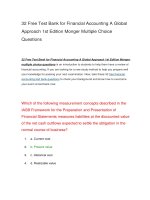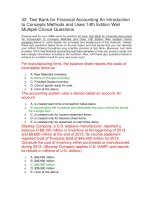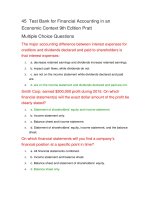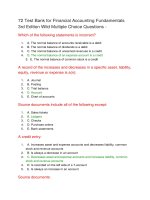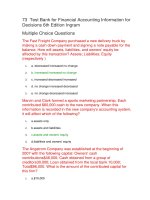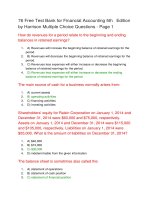81 test bank for financial accounting 4th
Bạn đang xem bản rút gọn của tài liệu. Xem và tải ngay bản đầy đủ của tài liệu tại đây (43.45 KB, 14 trang )
81 Test Bank for Financial Accounting 4th
Edition by Harrison
Multiple Choice Questions
Which of the following financial statements would a potential
investor most likely use to evaluate a company's financial
performance for the current period?
1.
2.
3.
4.
A. balance sheet
B. income statement
C. cash flow statement
D. retained earnings statement
Net income is:
1.
A. deducted from beginning retained earnings on the retained earnings
statement
2. B. added to beginning retained earnings on the retained earnings statement
3. C. added to assets on the balance sheet
4. D. deducted from net sales on the income statement
The accounting equation can be stated as:
1.
2.
3.
4.
A. Assets + Liabilities = Shareholders' equity
B. Assets = Liabilities + Shareholders' equity
C. Assets = Liabilities - Shareholders' equity
D. Assets + Shareholders' equity = Liabilities
The cash flow statement is divided into three categories relating
to cash flows from operating, investing, and:
1.
2.
3.
4.
A. management planning activities
B. financing activities
C. strategic positioning activities
D. marketing activities
All of the following are forms of business organizations except:
1.
2.
3.
4.
A. proprietorship
B. partnership
C. restaurant
D. corporation
Which of the following represent(s. claims to economic
resources?
1.
A. assets, but not liabilities or owners' equity
2.
3.
4.
B. owners' equity, but not assets or liabilities
C. liabilities, but not assets or owners' equity
D. liabilities and owners' equity, but not assets
Cost of goods sold is:
1.
2.
3.
4.
A. added to sales on the income statement
B. deducted from sales on the balance sheet
C. deducted from sales on the income statement
D. added to sales on the retained earnings statement
Common shares appear on the:
1.
2.
3.
4.
A. balance sheet
B. income statement
C. cash flow statement
D. retained earnings statement
The ending balance in retained earnings appears on the:
1.
2.
3.
4.
A. balance sheet only
B. balance sheet and statement of retained earnings
C. statement of retained earnings only
D. income statement
What is the proper order for the cash flow statement?
1.
2.
3.
4.
A. financing activities, investing activities, and operating activities
B. operating activities, investing activities, and financing activities
C. operating activities, financing activities, and investing activities
D. investing activities, financing activities, and operating activities
The owners' interest in the assets of a corporation is known as:
1.
2.
3.
4.
A. assets
B. shareholders' equity
C. expenses
D. revenues
Losses are reported on the:
1.
2.
3.
4.
A. income statement
B. balance sheet
C. cash flow statement
D. statement of retained earnings
Shareholders' equity for Raisin Corporation on January 1, 2010
and December 31, 2010 were $60,000 and $75,000, respectively.
Assets on January 1, 2010 and December 31, 2010 were
$115,000 and $105,000, respectively. Liabilities on January 1,
2010 were $55,000. What is the amount of liabilities on December
31, 2010?
1.
2.
3.
4.
A. $40,000
B. $15,000
C. $30,000
D. indeterminable from the given information
Operating expenses appear on the income statement:
1.
2.
3.
4.
A. directly after gross margin
B. directly after cost of goods sold
C. directly after revenue
D. do not appear on the income statement
Which of the following persons or groups have the ultimate
control of a corporation?
1.
2.
3.
4.
A. the chief executive officer
B. the board of directors
C. the audit committee
D. the shareholders
Cash dividends:
1.
2.
3.
4.
A. decrease revenue on the income statement
B. increase expenses on the income statement
C. decrease retained earnings on the retained earnings statement
D. decrease operating activities on the cash flow statement
The date of the income statement:
1.
2.
3.
4.
A. covers one day in time
B. covers a period of time, usually for an accounting period
C. is not dated
D. may cover a period of time or only one day in time, like a snapshot
photograph
Notes receivable due in 60 days would be classified as a:
1.
2.
3.
4.
A. long-term asset on the balance sheet
B. current asset on the balance sheet
C. current liability on the balance sheet
D. long-term liability on the balance sheet
To determine a company's gross margin for the period, an
investor would look on the:
1.
2.
3.
A. balance sheet
B. cash flow statement
C. income statement
4.
D. statement of retained earnings
Common shares is a component of:
1.
2.
3.
4.
A. total assets
B. total liabilities
C. share capital
D. retained earnings
Expenses are:
1.
2.
3.
4.
A. increases in assets resulting from operations
B. increases in retained earnings resulting from operations
C. increases in liabilities resulting from purchasing assets
D. decreases in retained earnings resulting from operations
Revenues are:
1.
A. increases in liabilities resulting from delivering goods or services to
customers
2. B. increases in retained earnings resulting from delivering goods or
services to customers
3. C. decreases in assets resulting from delivering goods or services to
customers
4. D. decreases in retained earnings resulting from delivering goods or
services to customers
Gains and losses appear on which of the financial statements
listed below?
1.
2.
3.
4.
A. the balance sheet
B. the income statement
C. the retained earnings statement
D. the cash flow statement
Suppose The Fruit Group buys a kiwi for $.10 and sells the kiwi
for $.50. The cost of goods sold would be:
1.
2.
3.
4.
A. $.10
B. $.40
C. $.50
D. $.05.
Which of the following best describes a liability?
1.
2.
3.
4.
A. Liabilities are a form of share capital.
B. Liabilities are future economic benefits to which a company is entitled.
C. Liabilities are accounts receivable of the company.
D. Liabilities are economic obligations to creditors to be paid at some future
date by the company.
Cash received from the sale of shares would appear:
1.
2.
3.
4.
A. as an operating activity on the cash flow statement
B. would not appear on a cash flow statement
C. as an investing activity on the cash flow statement
D. as a financing activity on the cash flow statement
On January 1, 2010, total assets for Liftoff Technologies were
$125,000; on December 31, 2010, total assets were $145,000.
On January 1, 2010, total liabilities were $110,000; on December
31, 2010, total liabilities were $115,000. What are the amount of
the change and the direction of the change in Liftoff Technologies
shareholders' equity for 2010?
1.
2.
3.
4.
A. decrease of $15,000
B. increase of $15,000
C. increase of $30,000
D. decrease of $30,000
Which of the following represent(s. claims to economic
resources?
1.
2.
3.
4.
A. assets, but not liabilities or owners' equity
B. owners' equity, but not assets or liabilities
C. liabilities, but not assets or owners' equity
D. liabilities and owners' equity, but not assets
The balance sheet is sometimes also called the:
1.
2.
3.
4.
A. statement of operations
B. statement of cash position
C. statement of financial position
D. statement of income and expense
How do revenues for a period relate to the beginning and ending
balances in retained earnings?
1.
A. Revenues will increase the beginning balance of retained earnings for
the period.
2. B. Revenues will decrease the beginning balance of retained earnings for
the period.
3. C. Revenues less expenses will either increase or decrease the beginning
balance of retained earnings for the period.
4. D. Revenues less expenses will either increase or decrease the ending
balance of retained earnings for the period.
Dividends:
1.
2.
A. always affect net income
B. are distributions to shareholders of assets (usually cash. generated by
net income
3. C. are expenses
4.
D. are distributions to shareholders of assets (usually cash. generated by a
favourable balance in retained earnings
Claims held by the shareholders (owners. of a corporation are
referred to as:
1.
2.
3.
4.
A. retained earnings
B. share capital
C. share capital minus retained earnings
D. share capital plus retained earnings
If liabilities increase $120,000 during a given period and
shareholders' equity decreases $25,000 during the same period,
assets must:
1.
2.
3.
4.
A. decrease $145,000
B. increase $145,000
C. increase $95,000
D. decrease $95,000
Dividends appear on the:
1.
2.
3.
4.
A. retained earnings statement
B. income statement
C. balance sheet
D. both the retained earnings statement and the income statement
Receivables are classified as:
1.
2.
3.
4.
A. increases in earnings
B. assets
C. decreases in earnings
D. liabilities
If assets increase $120,000 during a given period and liabilities
decrease $25,000 during the same period, shareholders' equity
must:
1.
2.
3.
4.
A. increase $95,000
B. decrease $145,000
C. decrease $95,000
D. increase $145,000
Financial statements are:
1.
A. reports issued by outside consultants who are hired to analyze key
operations of the business
2. B. reports created by management that states it is responsible for the acts
of the corporation
3. C. standard documents that tell us how well a business is performing and
where it stands in financial terms
4.
D. standard documents issued by outside consultants who are hired to
analyze key operations of the business in financial terms
Payables are classified as:
1.
2.
3.
4.
A. increases in earnings
B. assets
C. decreases in earnings
D. liabilities
Assets appear on the:
1.
2.
3.
4.
A. balance sheet
B. income statement
C. retained earnings statement
D. cash flow statement
An investor wishes to assess a company's financial position at the
end of the period. Which financial statement would the investor
probably examine?
1.
2.
3.
4.
A. the cash flow statement
B. the income statement
C. the balance sheet
D. the statement of retained earnings
81 Free Test Bank for Financial Accounting 4th
Canadian Edition by Harrison Multiple Choice
Questions-Page 2
According to the Canadian Institute of Chartered Accountants
(CICA., the primary objective of financial reporting is to provide
information:
1.
2.
3.
4.
A. to the federal government about tax matters
B. useful for making investment and lending decisions
C. regarding the cash flows of the business
D. about the profitability of the business
Increases in shareholders' equity arise from:
1.
2.
3.
4.
A. investments by the owner
B. payment of dividends
C. net income earned during the period
D. both investments by the owner and net income earned during the period
Cash would appear on the:
1.
2.
A. income statement with the revenues
B. retained earnings statement with the net income
3.
4.
C. balance sheet with the current assets
D. balance sheet with the current liabilities
Accounting standards for accountants in Canada are established
by:
1.
2.
3.
4.
A. the Canadian Institute of Chartered Accountants
B. the Society of Management Accountants of Canada
C. the Certified General Accountants Association of Canada
D. the Canadian Institute of Chartered Accountants, the Society of
Management Accountants of Canada, and the Certified General Accountants
Association of Canada
Purchases and sales of long-term assets are examples of:
1.
2.
3.
4.
A. investing activities
B. dividend activities
C. financing activities
D. operating activities
Depreciation is normally associated with which asset on the
balance sheet?
1.
2.
3.
4.
A. Land
B. accounts receivable
C. inventory
D. equipment
The principle that states that assets acquired by the business
should be recorded at their actual price is the:
1.
2.
3.
4.
A. objectivity assumption
B. stable monetary unit assumption
C. cost assumption
D. reliability assumption
Cash spent to purchase a new building would appear on the cash
flow statement as:
1.
2.
3.
4.
A. a financing activity
B. an operating activity
C. an investing activity
D. purchases of new equipment do not appear on a cash flow statement
The issuance of shares for cash would be classified as a(n.:
1.
2.
3.
4.
A. investing activity on a cash flow statement
B. financing activity on a cash flow statement
C. operating activity on a cash flow statement
D. current asset on the balance sheet
The balance sheet contains information about:
1.
2.
3.
4.
A. liabilities, equity, and expenses
B. assets, revenues, and liabilities
C. assets, liabilities, and equity
D. revenues, expenses, and equity
What is one component of shareholders' equity?
1.
2.
3.
4.
A. common shares
B. notes payable
C. property, plant, and equipment
D. cash
The stable-monetary-unit assumption is the basis for ignoring:
1.
A. the possibility that the value of inventory might drop below its historical
cost
2. B. fluctuations in the value of the Canadian dollar relative to foreign
currencies
3. C. the effect of inflation in the accounting records
4. D. the difference between the appraised value and the actual cost when
recording an asset at its historical cost
When a repurchase of shares is done by a company it:
1.
2.
3.
4.
A. increases the amount of owners' equity
B. decreases the amount of owners' equity
C. decreases the amount of total liabilities
D. increases the amount of total liabilities
Which financial statement is based on the accounting equation?
1.
2.
3.
4.
A. statement of retained earnings
B. income statement
C. cash flow statement
D. balance sheet
The income statement presents a summary of the:
1.
2.
3.
4.
A. revenues and expenses of an entity for a specific time period
B. assets and liabilities of an entity
C. cash inflows and outflows of an entity
D. changes that occurred in the shareholders' equity of an entity
All of the following are considered standard financial statements
except the:
1.
2.
3.
4.
A. statement of earnings
B. statement of assets
C. statement of retained earnings
D. cash flow statement
Which of the following statements below is true?
1.
2.
3.
A. The value of a dollar changes over time.
B. British accountants are required to record transactions in dollars.
C. The stable-monetary-unit assumption requires adjustments to the
accounting records for the effects of inflation.
4. D. High inflation rates indicate a dollar's purchasing power is stable when
compared with other currencies.
Current assets are assets expected to be converted to cash, sold,
or consumed:
1.
A. within the next 12 months or within the business's normal operating cycle
if less than a year
2. B. within the next 12 months or within the business's normal operating cycle
if longer than a year
3. C. within the next 6 months
4. D. within the next 24 months
Retained earnings appears on which of the following financial
statements?
1.
A. statement of retained earnings, cash flow statement, and income
statement, but not the balance sheet
2. B. statement of retained earnings and balance sheet, but not the income
statement or cash flow statement
3. C. statement of retained earnings, cash flow statement, and balance sheet,
but not the income statement
4. D. statement of retained earnings and cash flow statement, but not the
income statement or balance sheet
Which of the following financial statements provides a "snapshot
photo" of one moment in time?
1.
2.
3.
4.
A. balance sheet
B. income statement
C. statement of retained earnings
D. cash flow statement
The payment of salaries would appear:
1.
2.
3.
4.
A. on the cash flow statement with the operating activities
B. on the balance sheet with the current liabilities
C. on the income statement with the revenues
D. on the income statement as part of cost of goods sold
The repayment of a note payable would be classified as a(n.:
1.
2.
3.
4.
A. investing activity on a cash flow statement
B. financing activity on a cash flow statement
C. operating activity on a cash flow statement
D. current asset on the balance sheet
Decreases in shareholders' equity result from:
1.
2.
3.
4.
A. owner investments
B. a net loss during the period
C. a net income during the period
D. owner investments and a net loss during the period
Income taxes owed to the federal government would be classified
as a:
1.
2.
3.
4.
A. current asset on the balance sheet
B. current liability on the balance sheet
C. long-term asset on the balance sheet
D. financing activity on the cash flow statement
The accounting concept that maintains that each organization or
section of an organization stands apart from other organizations
and individuals is known as the:
1.
2.
3.
4.
A. reliability principle
B. going-concern assumption
C. entity assumption
D. monetary unit assumption
The amount of net income shown on the income statement also
appears on the:
1.
2.
3.
4.
A. balance sheet
B. statement of assets
C. statement of financial position
D. statement of retained earnings
The relevant measure of value of the assets of a company that is
going out of business is its:
1.
2.
3.
4.
A. historical cost
B. recorded value
C. book value
D. Liquidation value
When accounting for cash collected from customers, the
transaction would appear on the cash flow statement as a(an.:
1.
2.
3.
4.
A. operating activity
B. financing activity
C. investing activity
D. activity that would not appear on the cash flow statement.
In order for information to be considered a faithful representation
it must be all of the following except:
1.
2.
3.
4.
A. complete
B. predictive
C. without material error
D. neutral
Which financial statement must be prepared before the others?
1.
2.
3.
4.
A. income statement
B. balance sheet
C. cash flow statement
D. retained earnings statement
Accounts payable would appear on the:
1.
2.
3.
4.
A. income statement with the expenses
B. retained earnings statement with the dividends
C. balance sheet with the current assets
D. balance sheet with the current liabilities
Assets are generally divided into:
1.
2.
3.
4.
A. current assets and solvent assets
B. current assets and reliable assets
C. long-term assets and solvent assets
D. current assets and long-term assets
The ________ assumption assumes that the organization will
remain in operation long enough to use existing assets.
1.
2.
3.
4.
A. cost
B. stable monetary unit
C. entity
D. going-concern
The oldest organization of professional accountants in Canada is
the:
1.
2.
3.
4.
A. Canadian Institute of Chartered Accountants
B. Securities and Exchange Commission
C. Financial Accounting Standards Board
D. Auditing Standards Board
The balance sheet contains:
1.
2.
3.
4.
A. the amount of net income
B. the beginning balance in retained earnings
C. the ending balance in retained earnings
D. the amount of dividends paid to shareholders
Which of the following statements should be prepared before the
balance sheet is prepared?
1.
2.
3.
4.
A. statement of retained earnings
B. cash flow statement
C. statement of financial position
D. both the statement of retained earnings and the cash flow statement
The statement that presents a summary of the revenues and
expenses of an entity is called the:
1.
2.
3.
4.
A. balance sheet
B. cash flow statement
C. statement of retained earnings
D. income statement
The main source of cash for a business stems from:
1.
2.
3.
4.
A. current assets
B. operating activities
C. financing activities
D. investing activities
Which of the following financial statements shows the net
increase or decrease in cash during the period?
1.
2.
3.
4.
A. balance sheet
B. income statement
C. statement of retained earnings
D. cash flow statement
Equipment would appear on the:
1.
2.
3.
4.
A. income statement with the revenues
B. balance sheet with the long-term assets
C. balance sheet with the current assets
D. income statement with the operating expenses
The CEO of a business owns a home and two automobiles. The
company the CEO works for also owns automobiles and a home
in a remote area used for strategic planning meetings by its
executives. Which principle or assumption "draws a sharp
boundary" around the possessions of the CEO and the assets of
the business for which he works?
1.
2.
3.
4.
A. the entity assmption
B. the stable-monetary-unit assumption
C. the going-concern assumption
D. the objectivity assumption
